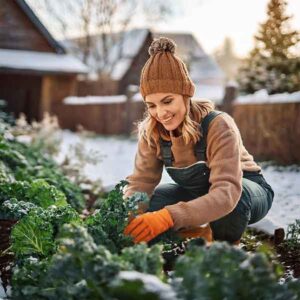
Winter doesn’t mean your garden has to go dormant. Having a homestead means that it is crucial that your land provides for you year-round, even in the winter. With the right preparation and crop selection, you can keep your garden vibrant and productive even when the temperature drops. By choosing the right crops and preparing your garden both for and after winter, you can create a year-round gardening cycle. Winter gardening not only provides fresh produce when it’s most needed but also keeps your gardening skills sharp and your garden alive with activity, even when the world outside seems to be on pause.
Top Winter Crops for Your Garden
The first hurdle we have to overcome with a winter garden is finding what will actually grow.
Kale: Kale thrives in cooler weather, becoming sweeter after a frost. It’s packed with nutrients.
Plant kale in late summer or early fall. Ensure it gets plenty of sun and mulch around the base for insulation.
Brussels Sprouts: Like kale, cold weather improves their flavor. They can handle frost and even light snow. Start seedlings indoors in mid-summer for transplanting in late summer. Space them well as they need room to grow.
Winter Greens (Spinach, Swiss Chard, Arugula): These greens tolerate cold and provide fresh salad greens during winter. Sow seeds directly in late summer or early fall. They can be harvested as baby greens or allowed to mature.
Carrots: Carrots can remain in the ground through winter for sweet, tender roots. Sow seeds in early fall. For harvesting, mulch heavily or cover with protection or row cover.
Garlic: Plant in fall, and it’s ready in late spring or early summer. Frost improves its flavor. Break apart garlic heads into cloves and plant the largest cloves pointy end up, about 2 inches deep.
Winter Squash: While they’re harvested in late summer, storing them properly means you can enjoy them through winter. Plant in early summer for a late fall harvest. Cure before storing in a cool, dry place.
Leeks: Leeks can stay in the ground through winter, getting sweeter as it gets colder. Start seeds indoors in early spring, then transplant in mid-summer for winter harvesting.
Preparing Your Garden for Winter
Just because your garden just ended the summer planting season does not mean that all is well. It is good practice to follow these steps after or before each new planting season starts.
Soil Testing: Test soil pH and nutrient levels, adding amendments like lime, compost, or well-rotted manure to improve soil health.
Mulching: Apply a thick layer of mulch (straw, leaves, or pine needles) to insulate plants, prevent soil erosion, and retain moisture.
Plant Protection: Specifically we are trying to continue to use our outdoor garden, reserving the greenhouse for other food that is less cold tolerant. Take advantage of row covers & cold frames to basically make mini greenhouses for your outdoor garden. Use these to extend the growing season. Row covers protect against frost, while cold frames can turn your garden into a mini greenhouse. Cloches are Individual plant covers that can protect against harsh weather.
Watering: Reduce watering as plant growth slows, but ensure plants go into winter with adequate moisture.
Garden Layout: Plant winter crops in locations that will receive maximum sunlight during the shorter days of winter.
Post-Winter Garden Preparation
Just because the winter growing season is over, does not mean that we can rest on our laurels. Right around the corner is the next season and the more we can prepare a hard of time will set us up for success.
Cleanup: Remove debris and clear away dead plant material to prevent disease and pests from overwintering. It’s best to remove heavy mulches in spring to allow soil to warm up especially in areas with heavy frost lines. The faster we can thaw the ground the better.
Soil Preparation: Light tilling can help incorporate organic matter into the soil. However, avoid excessive tilling which can disrupt soil structure. If your soil is compacted, aerate it to improve water and nutrient penetration.
Fertilization: Incorporate compost into your garden beds to replenish nutrients depleted over the winter.
Dig deeper- Offseason Garden Prep
Planning for Spring
Crop Rotation: Plan your next season’s planting with crop rotation in mind to prevent soil depletion and pest problems. Carrots for example can take up a lot of nitrogen from the soil. After you plant carrots, it may be a good idea to follow up with legume plants, or try planting clover or alfalfa for the animals.
Seed Starting: Begin indoor seed starting for early spring crops like tomatoes and peppers.
Irrigation Systems: Don’t wait for inspecting your watering lines, fixing problems now ensures your irrigation system is ready for spring. Winter can be harsh on outdoor plumbing.
Beyond just having food for your family there are other benefits to having a winter garden. Ok this is the hippy in me but by extending the growing season, you reduce the need for long-distance transportation of produce, lowering your carbon footprint. If that doesn’t get you jumping on a winter garden, how about that your soil doesn’t remain fallow or compacted; instead, it’s kept alive with root activity, which can improve soil structure and fertility. Which makes your spring garden that much easier to work. Winter gardens can provide food for wildlife or pollinators that might still be active, contributing to ecological balance. If you think about it, having a clover plot means that you will attract deer. Deer means meat in the freezer- just saying. And lastly, the time and effort in keeping up with your land. There is no reason once winter hits that you should not stay busy doing something. Gardening is a form of physical activity that also benefits mental health, offering a peaceful, engaging activity during a season often associated with less outdoor time. Remember idle hands are the devils workshop.
By engaging in winter gardening, you not only extend your gardening season but also contribute positively to your health and local environment. This practice embraces the idea that gardening isn’t just a summer activity; it’s a year-round endeavor that can bring joy, sustainability, and resilience to your life. With the benefits of cost savings, your winter homegrown produce can be cheaper than store bought. This is especially true when combined with a greenhouse since out of season fruits and vegetables can be quite pricey.
Access to fresh, organic vegetables during winter ensures a continuous supply of vitamins and minerals, which are crucial during the colder months when people are more susceptible to illnesses. Winter crops like kale, spinach, and root vegetables add variety to your diet, which can be limited in terms of fresh local produce during winter.
Hopefully this opened your eyes to the fact that you can use your land year-round. Gardening does not have to be a fair weather affair.
– – James Nicholas
